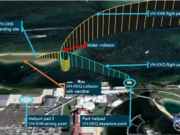
The following information provides an awareness of problems that might be avoided in the future. The information is based on final reports by official investigative authorities on aircraft accidents and incidents.
 Jets
Jets
Safety Area Save
Boeing 737-600. No damage. No injuries.
Excess speed, a tailwind, a long landing and delayed application of reverse thrust were among the factors that contributed to the overrun of the 737 at Montreal’s Pierre Elliott Trudeau International Airport, the afternoon of June 5, 2015, said the Transportation Safety Board of Canada (TSB).
“The aircraft touched down in heavy rain showers about 2,550 feet [777 meters] beyond the threshold of Runway 24L and did not stop before reaching the end of the runway,” the TSB report said. The aircraft came to a stop in a runway end safety area (RESA). There were no injuries to the 107 passengers and five crewmembers, and no damage to the 737.
En route from Toronto, the flight crew learned from the automatic terminal information service recording that surface winds were from 240 degrees at 8 kt and that visibility was 15 mi (24 km) in light rain showers, with bases of towering cumulus clouds 4,500 ft above the Montreal airport. The pilots planned to conduct a visual approach to Runway 24L with the instrument landing system (ILS) as a backup. Expecting good braking action, they also planned to land with 30 degrees of flap and the autobrake system set to the lowest level. Calculated landing distance on the 9,600-ft (2,926-m) runway was 7,784 ft (2,373 m). The crew expected to turn off the runway onto the last taxiway, which was closest to their parking area.
The 737 was established on the ILS when it encountered heavy rain showers. The tower controller reported that the surface winds were from 350 degrees at 17 kt, gusting to 22 kt. Although the landing reference speed was 125 kt, the aircraft crossed the runway threshold at 145 kt. It touched down 10 seconds later on the right main landing gear at 133 kt. Still expecting good braking action, “the crew continued to implement their plan to use minimal deceleration … to exit at the end of the runway,” the report said.
“At a speed of 103 knots, with 4,940 feet [1,506 m] of runway remaining, the PF [pilot flying, the captain] manually stowed the speed brakes, which disarmed the autobrakes,” the report said. The aircraft was traveling at 92 kt about nine seconds later when the captain applied full manual braking and maximum reverse thrust.
Likely due to viscous hydroplaning, the 737 did not decelerate as it neared the end of the runway, the report said. The captain steered the aircraft right, to avoid striking the runway end lights and approach lights. The aircraft ran off the pavement at 39 kt and traveled about 200 ft (61 m) on the grassy surface of the RESA before stopping. The occupants deplaned on a mobile staircase.
Crushed Ped Ignites
Boeing 747-400. Minor damage. No injuries.
En route from Los Angeles, the 747 was about 500 km (270 nm) from New York the morning of June 21, 2016, when a passenger asked a cabin crewmember for help in finding a missing personal electronic device (PED). The crewmember found that the PED had become lodged in the passenger’s seat-adjustment mechanism.
The device had been crushed when the seat was moved during the search. “The crushed PED immediately began hissing and emitting smoke,” said the report by the Australian Transport Safety Bureau (ATSB). “Moments later, the PED ignited.” Cabin crewmembers discharged fire extinguishers into the seat, dousing the flames and the subsequent orange glow from the PED.
“The PED could not be removed without further damage and risk of fire,” the report said. “Therefore, the cabin crew elected to leave the device in place and position a crewmember with a fire extinguisher near [the] seat for the remainder of the flight.” The crewmember subsequently used the extinguisher to eliminate increasing heat produced by the device.
The aircraft was landed in New York 40 minutes after the incident. “Two passengers reported feeling unwell after the event, but it was unclear if this was as a result of the incident,” the report said.
The report said that the PED had lithium batteries, which “are capable of ignition and subsequent explosion due to overheating.” The operator of the 747 told the ATSB that 22 similar incidents had involved PEDs that had become trapped or crushed. “Seven of these occurrences resulted in smoke and/or heat being produced,” the report said. “This incident was the first event to result in fire [aboard the operator’s aircraft].”
Floating With a Tailwind
Boeing 737-800. Substantial damage. No injuries.
The flight crew had prepared to land on Runway 03 at Makassar, Indonesia, the morning of June 2, 2015, but as the 737 neared the airport, airport traffic controllers saw cumulonimbus clouds in the approach area and vectored the crew to intercept the ILS approach to Runway 13, which was 2,500 m (8,203 ft) long.
During the approach, the pilots noticed that heavy rain was falling near the end of the runway. Their navigation displays indicated a 10-kt right crosswind and a 10-kt tailwind component. “The flight crew did not consider a go-around as they were aware that the takeoff area of Runway 13 was mountainous and might jeopardize the flight,” said the report by the Indonesian National Transportation Safety Committee.
Groundspeed was 170 kt as the aircraft crossed the runway threshold. The aircraft floated for about 13 seconds before touching down about 1,435 m (4,708 ft) beyond the threshold. The captain steered left as the 737 neared the end of the runway. “The aircraft stopped at the left side of the stopway with the nose landing gear and left main landing gear stuck in the mud while the right main landing gear remained on the stopway,” the report said. None of the 153 occupants was injured.
Uncommanded Reverse Thrust
IAI Westwind. Destroyed. Three fatalities.
No system anomalies had occurred during the first of two scheduled pilot-in-command (PIC) proficiency checks the afternoon of June 18, 2014. The pilot who had passed the first check ride then took a seat in the cabin, and another company pilot occupied the left cockpit seat for his PIC proficiency check. Recorded flight data indicated that the subsequent takeoff from Huntsville, Alabama, U.S., was initiated with the flaps retracted, the thrust reversers armed and both engines stabilized at 96 percent.
Shortly after the “V1” call was recorded, right engine thrust decreased in a manner consistent with a simulation by the pilot examiner of an engine failure, said the report by the U.S. National Transportation Safety Board (NTSB). The pilot continued the takeoff and called for the landing gear to be retracted. “The landing gear remained extended, and about one second after the command to retract the landing gear — or about three seconds after becoming airborne — while about 33 ft above the runway and at the highest recorded airspeed of 149 knots, the CVR [cockpit voice recorder] recorded the beginning of a rattling sound, which was consistent with the deployment of the right thrust reverser,” the report said.
The examiner asked, “What happened?” This indicated that the deployment had not been annunciated, the report said. The Westwind rolled right and began to decelerate. The right turn continued after the landing gear was retracted. Airspeed was about 132 kt, and the last recorded bank angle was 39 degrees. “The airplane impacted the ground off the right side of the runway in a nose- and right-wing-low attitude,” the report said.
Noting that certification flight tests of the Westwind had shown that the airplane was controllable after an uncommanded thrust reverser deployment, NTSB concluded that the probable cause of the accident was “the flight crew’s inability to maintain airplane control.”
“A definitive reason for the deployment of the right thrust reverser could not be determined,” the report said. “No previous instances of inadvertent in-flight thrust reverser deployment were documented by the operator of the accident airplane or by the airframe manufacturer.”
 Turboprops
Turboprops
Short Flight, Shorter Fuel
Beech King Air 100. Substantial damage. Four minor injuries.
The pilot checked the fuel gauges and judged, incorrectly, that there was sufficient fuel for a 15- to 20-minute post-maintenance test flight around Montreal Saint-Hubert Airport to check the rudder trim indicator and a possible problem in synchronization between the autopilot and global positioning system the afternoon of June 10, 2013, the TSB report said.
About 16 minutes after taking off with the company’s maintenance director and two passengers aboard, the pilot reported 25 nm (46 km) south of the airport and requested, and received, clearance to conduct a practice ILS approach to Runway 24R. The aircraft was about 8 nm (15 km) northeast of Saint-Hubert and in a left turn to intercept the localizer when the right engine flamed out due to fuel exhaustion. Flameout of the left engine followed soon thereafter.
“The pilot did not carry out the approved engine failure procedure when the first engine stopped, and [consequently] the propeller was not feathered, resulting in significant drag,” the report said.
The pilot turned toward Saint-Mathieu-de-Beloeil Airport, about 3 nm (6 km) east and extended the landing gear. “The pilot’s decision to lower the landing gear while the aircraft was at 1,600 feet above sea level further increased the drag, reducing the aircraft’s gliding range,” the report said.
Apparently realizing that the aircraft could not reach the airport, the pilot turned toward a field. However, the King Air stalled before reaching the field. “The right wing touched the ground at an angle of approximately 45 degrees, then the aircraft hit a fence and a tree before severing two electrical wires and violently striking the grass-covered ground,” the report said. The aircraft came to a stop on its lower fuselage. The four occupants sustained minor injuries on impact but were able deplane through the emergency exit.
Checklist Omitted
Short Brothers SD3-60. Substantial damage. No injuries.
The first officer and a company check pilot had completed several takeoffs and landings at Kapolei, Hawaii, U.S., the afternoon of June 29, 2015, and planned to make the last landing with the flaps only partially extended. “The pilots reported that the approach was uneventful and that they thought that they had completed the ‘Before Landing’ checklist, which included extending the landing gear and verifying that it was down before landing,” the NTSB report said.
However, the landing gear was not extended, and the warning horn did not activate because the flaps were not extended fully and the power levers had not been pulled back to flight idle. “The airplane had a tricycle landing gear with a fully retractable nose gear and partially retractable main gear,” the report said. Shortly after the airplane touched down on the protruding main landing gear, the forward section of the lower fuselage struck the runway and was substantially damaged.
‘Tipped Onto Its Tail’
Cessna 208B. Substantial damage. No injuries.
Neither the pilot nor the copilot noticed that the tail stand had not been installed before the passengers were boarded for a charter flight from Fort Dodge, Iowa, U.S., the morning of June 5, 2016. “The pilot-in-command reported that during the loading of the seventh and final passenger, the airplane tipped onto its tail and impacted the ramp surface,” the NTSB report said.
Photographs of the tail section were sent to the company’s maintenance office. An incident report submitted by the company to NTSB said that no “major damage” was identified during a visual inspection of the photos. The airplane was released for service, and the flight crew completed the revenue flight. (The destination was not specified by the NTSB report.)
However, “after the airplane reached a company domicile, the airplane was grounded after a further visual inspection revealed substantial damage to the aft bulkhead,” the report said.
 Piston Airplanes
Piston Airplanes
‘Instrument Problems’
Cessna 340A. Destroyed. One fatality.
Shortly after taking off from Fort Lauderdale, Florida, U.S., for an instrument flight rules business flight to Leesburg, Florida, the morning of June 8, 2013, the pilot told the departure controller that he was having “instrument problems” and wanted to proceed under visual flight rules (VFR) at 2,000 ft. The controller repeated that information to the next sector controller.
When the next controller asked if the pilot could climb to 8,000 ft, “the pilot stated that he would climb the airplane after clearing a cloud and reiterated that the airplane was having ‘instrument problems,’” the NTSB report said. About 30 seconds later, the pilot reported that he was climbing to 8,000 ft. He then acknowledged a further instruction to climb to 11,000 ft.
After being handed off to a center controller, the pilot was advised that there was an area of moderate-to-heavy precipitation ahead and that he could deviate as necessary. “The pilot did not advise the center controller about the instrument problems,” the report said. “The airplane subsequently began turning east, eventually completing about an 80-degree turn toward heavier precipitation.”
The controller twice queried the pilot but received no response. Finally, the pilot said, “I have an instrument failure here” and that he was trying to “maintain VFR.” The controller advised that the turn to the east was “a very bad idea” and that the pilot should turn west “to get out of this stuff a lot quicker.” There was no response.
The 340 was in moderate-to-heavy precipitation when it entered a steep descent. The pilot recovered near ground level and initiated a climb. The airplane entered clouds at 1,500 ft, stalled and descended into a wildlife refuge near Boynton Beach.
The airplane was equipped with weather radar, a lightning detector and redundant flight and navigation instruments. However, the report said that the wreckage was “extremely fractured” and that investigators were unable to determine the nature of the instrument problems the pilot had reported.
Overweight in Thin Air
Beech 77 Duchess. Substantial damage. No injuries.
The pilot told investigators that he had worked 12 hours a day during the preceding four days and was fatigued when he departed from Santa Fe, New Mexico, U.S., the night of June 15, 2016, for a personal flight with one passenger to Utah. He said that the airplane “was not climbing well” after takeoff. Unable to gain altitude, the pilot landed the Duchess on a highway. “The pilot swerved to avoid a car and struck a road sign, which substantially damaged the left wing,” the NTSB report said.
The pilot told investigators that the airplane was about 140 lb (64 kg) over gross weight on takeoff. Airport elevation was 6,350 ft, and investigators calculated that the density altitude was 8,202 ft when the accident occurred.
Weather Obscures a Pass
Grumman G-21A Goose. Destroyed. One fatality.
The amphibious airplane was not maintained for instrument flight, and the pilot already had diverted twice due to weather. After waiting in Salmon, Idaho, U.S., for conditions to improve, the pilot again attempted to complete the VFR flight to Hamilton, Montana, the afternoon of June 17, 2014.
“The route of flight followed a highway that traversed a mountain pass,” the NTSB report said. “A witness located along the highway stated that he saw the accident airplane traveling northbound toward the mountain pass, below the overcast cloud layer. He also stated that the mountain pass was obscured.”
Another witness, located in the 7,000-ft mountain pass near Sula, Montana, said he saw the Goose emerge from a cloud base in a flat spin and strike the ground. “The second witness reported that it was snowing and that the visibility was about 1/4 mile [400 m] at the time of the accident,” the report said. Investigators concluded that the pilot likely had become spatially disoriented and had lost control of the airplane.
 Helicopters
Helicopters
Mast Bumping in Turbulence
Bell 206B JetRanger. Destroyed. One fatality.
After disembarking two passengers in a mountainous area near Creg-ny-Baa on the Isle of Man the morning of June 6, 2015, the pilot lifted off into surface winds gusting to 46 kt. Witnesses saw the helicopter enter a series of roll oscillations as it flew up the valley. “The nose of the helicopter then pitched up into the rotor disc, being destroyed as it did so,” said the report by the U.K. Air Accidents Investigation Branch. “The fuselage of the helicopter, its rotors and many fragments then fell separately to the ground.”
Examination of the wreckage indicated that the main rotor mast had failed catastrophically in flight. “There was clear evidence that this had been due to heavy ‘mast bumping’ contact between the teeter (‘static’) stops on the main rotor head and the main rotor mast,” the report said.
Noting that the JetRanger’s flight manual did not specify a wind limit, the report said that the mast failure likely occurred as the pilot was making large control inputs to maintain a stable flight path in the turbulence caused by the high winds.
Flight Path Obstruction
Eurocopter AS350-B2. Substantial damage. One fatality, one serious injury, two minor injuries.
Another helicopter was parked on the hospital helipad, so the AS350 pilot landed the emergency medical services helicopter on a paved road next to the hospital in Talihina, Oklahoma, U.S., the afternoon of June 11, 2013. During the pre-departure safety briefing an hour later, the pilot told the medical crewmembers about a 20-ft (6-m) metal lamp post off the left side of the road near the helicopter. However, he apparently was not aware of a 40-ft (12-m) lamp post farther down the road, the NTSB report said.
During departure, the main rotor blades struck the taller lamp post. “The pilot was unable to maintain control of the helicopter, and the helicopter impacted the ground and came to rest on its right side about 230 ft [70 m] from the takeoff point,” the report said. The patient was killed, the flight nurse was seriously injured, and the flight paramedic and the pilot sustained minor injuries in the crash. “The pilot reported that during the takeoff and before impact, he never saw the 40-ft lamp post,” the report said.
Carb Ice Chokes Engine
Robinson R22 Beta. Substantial damage. No injuries.
Shortly after departing from Bringeland, Norway, the afternoon of June 14, 2016, the air-tour helicopter began to lose power. When the low rotor speed warning sounded, the pilot initiated an emergency landing. The landing gear collapsed during the hard landing on sloping terrain, and the R22 rolled over.
Investigators for the Accident Investigation Board of Norway (AIBN) determined that the power loss likely had been caused by carburetor icing. Weather conditions were conducive to carb icing, and the pilot “confirmed that he had chosen not to use carburetor heat,” the AIBN report said.
| Date | Location | Aircraft Type | Aircraft Damage | Injuries |
|---|---|---|---|---|
| NA = not available
This information, gathered from various government and media sources, is subject to change as the investigations of the accidents and incidents are completed. |
||||
| April 1 | Yei, South Sudan | Let 410UVP | substantial | 20 NA |
| Some of the passengers sustained minor injuries when the aircraft veered off the runway after the pilot rejected a takeoff due to an engine problem. | ||||
| April 2 | Tampa, Florida, U.S. | Airbus A319-114 | substantial | none |
| The A319 was being prepared for a flight to Canada when a motor coach struck the left fuselage and flap track. | ||||
| April 7 | Atlanta, Georgia, U.S. | Cessna 414 | substantial | 1 none |
| The pilot said that he was distracted on final approach by another airplane that was cleared to enter the runway. The 414 touched down with the landing gear retracted. | ||||
| April 7 | Eugene, Oregon, U.S. | Piper PA-46-310P | destroyed | 4 fatal |
| Instrument meteorological conditions (IMC) and moderate-to-severe turbulence prevailed when the Malibu struck terrain during an instrument approach. | ||||
| April 10 | Sibu, Malaysia | Boeing 737-800 | NA | 67 none |
| The 737 veered off the runway after touching down in rain showers. | ||||
| April 10 | Alicante, Spain | Boeing 757-200 | substantial | 238 none |
| The 757 was substantially damaged when the tail struck the runway on touchdown. | ||||
| April 11 | Salzburg, Austria | Gulfstream IV | substantial | 4 none |
| The flight crew turned back to Salzburg after departing on a flight to the United States. The nose landing gear collapsed on landing. | ||||
| April 12 | Oksibil, Indonesia | Cessna 208 | destroyed | 1 fatal |
| The Caravan struck a 7,100-ft mountain 10 km (5 nm) from the airport during a cargo flight to Oksibil. | ||||
| April 12 | Kopinang, Guyana | Britten-Norman Islander | substantial | 2 NA |
| No fatalities were reported when the Islander veered off a wet airstrip on landing. | ||||
| April 13 | Orchid Island, Taiwan | Viking Air Twin Otter | substantial | 3 minor, 16 none |
| Three passengers sustained minor injuries when the Twin Otter veered off the runway and struck a railing while landing with a strong crosswind. | ||||
| April 17 | Cascais, Portugal | Piper Cheyenne | destroyed | 5 fatal, 3 minor |
| The pilot, three passengers and a person on the ground were killed, and three people on the ground sustained minor injuries when the Cheyenne crashed in a parking lot shortly after takeoff. | ||||
| April 19 | Bangkok | Airbus A320-232 | substantial | none |
| The lower fuselage of the A320 was substantially damaged when it was struck by a conveyer-belt vehicle while being prepared for departure. | ||||
| April 21 | Timmonsville, South Carolina, U.S. | Bell-Carson 47G | destroyed | 1 fatal |
| The helicopter struck trees and crashed inverted while approaching the site of a fund-raising event to drop golf balls. | ||||
| April 23 | Talbot Bay, Western Australia, Australia | Robinson R44 | substantial | 2 minor injuries |
| The R44 crashed in the bay shortly after a low rotor speed warning was generated on takeoff. | ||||
| April 23 | Covington, Louisiana, U.S. | Piper Chieftain | substantial | 2 none |
| The left wing struck a tree during an emergency landing in field after an engine lost power during cruise flight. | ||||
| April 25 | Huntsville, Texas, U.S. | Cessna 421C | destroyed | 1 fatal |
| The pilot reported engine problems before the 421 struck terrain during a post-maintenance test flight. | ||||
| April 27 | Newton, North Carolina, U.S. | Robinson R44 | substantial | 2 minor |
| The helicopter struck terrain after entering a spin while circling to photograph construction work during a pipeline-patrol flight. | ||||
| April 28 | Amarillo, Texas, U.S. | Pilatus PC-12 | destroyed | 3 fatal |
| IMC prevailed when the PC-12 struck terrain while departing for an emergency medical services flight. A medical crewmember and both pilots were killed. | ||||
| April 29 | San Cristóbal, Cuba | Antonov 26 | destroyed | 8 fatal |
| The An-26 struck a mountain during a military training flight. | ||||
| April 30 | Schefferville, Quebec, Canada | Piper Navajo | 2 fatal | |
| The Navajo struck power cables and crashed while returning from a geological survey flight. | ||||



